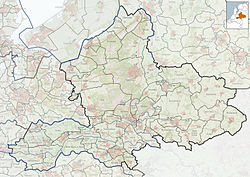Braamt | |
|---|---|
 Church with bell tower | |
| Coordinates: 51°55′26″N 6°15′52″E / 51.92393°N 6.26440°E | |
| Country | Netherlands |
| Province | Gelderland |
| Municipality | Montferland |
| Area | |
| • Total | 8.19 km2 (3.16 sq mi) |
| Elevation | 12 m (39 ft) |
| Population (2021)[1] | |
| • Total | 1,560 |
| • Density | 190/km2 (490/sq mi) |
| Time zone | UTC+1 (CET) |
| • Summer (DST) | UTC+2 (CEST) |
| Postal code | 6941[1] |
| Dialing code | 0316 |
Braamt is a village in the municipality of Montferland in the province of Gelderland, the Netherlands.
History
[edit]It was first mentioned in 1241 as Brameth, and means "place where blackberries grow".[3] De Kemnade is a havezate near Braamt on the Oude IJssel. The estate was first mentioned in 1418, and the tower dates from the 16th century.[4] In 1840, it was home to 292 people. In 1918, a school was built and the church dates from 1950.[5]
The Braamse Molen is a wind mill from 1856. In the 1990s, it was in very poor condition. It was purchased in 2017, and in 2021 the restoration of the wind mill commenced.[6]
Gallery
[edit]-
Stroomboek
-
House in Braamt
References
[edit]- ^ a b c "Kerncijfers wijken en buurten 2021". Central Bureau of Statistics. Retrieved 23 March 2022.
- ^ "Postcodetool for 6941AA". Actueel Hoogtebestand Nederland (in Dutch). Het Waterschapshuis. Retrieved 23 March 2022.
- ^ "Braamt - (geografische naam)". Etymologiebank (in Dutch). Retrieved 23 March 2022.
- ^ Ronald Stenvert & Sabine Broekhoven (2000). "Braamt" (in Dutch). Zwolle: Waanders. ISBN 90 400 9406 3. Retrieved 23 March 2022.
- ^ "Braamt". Plaatsengids (in Dutch). Retrieved 23 March 2022.
- ^ "Braamse Molen / Koenders Möl". Molen database (in Dutch). Retrieved 23 March 2022.





Well, that’s interesting to know that Psilotum nudum are known as whisk ferns. Psilotum nudum is the commoner species of the two. While the P. flaccidum is a rare species and is found in the tropical islands. Both the species are usually epiphytic in habit and grow upon tree ferns. These species may also be terrestrial and grow in humus or in the crevices of the rocks.
View the detailed Guide of Psilotum nudum: Detailed Study Of Psilotum Nudum (Whisk Fern), Classification, Anatomy, Reproduction